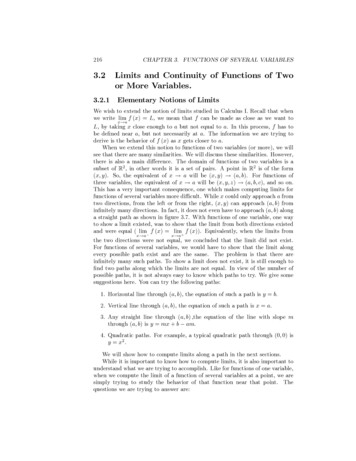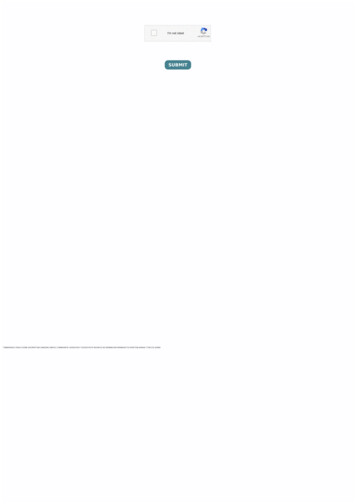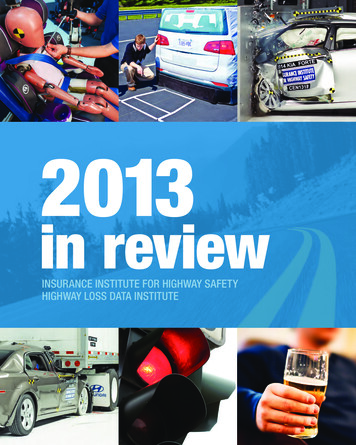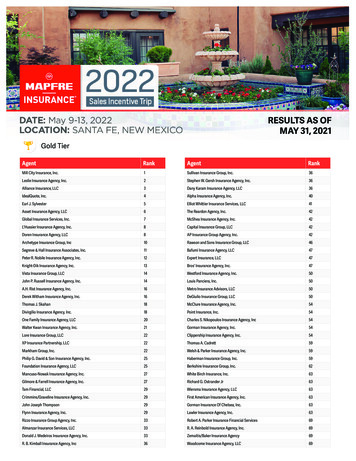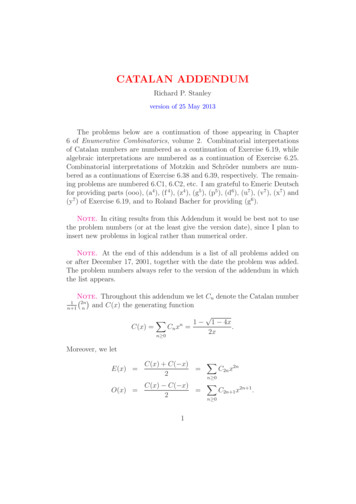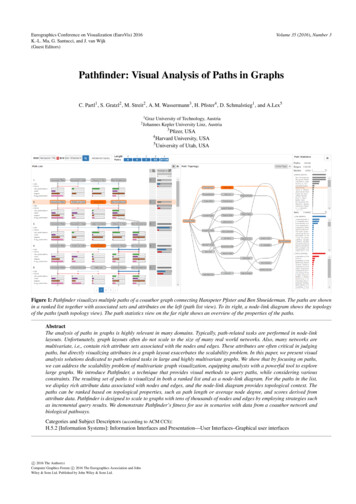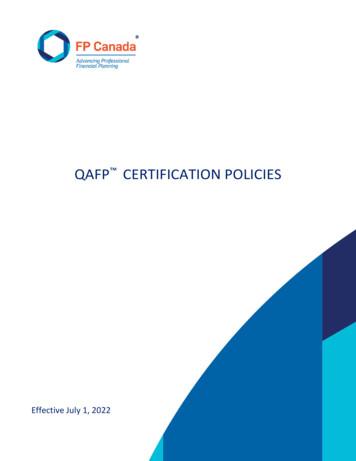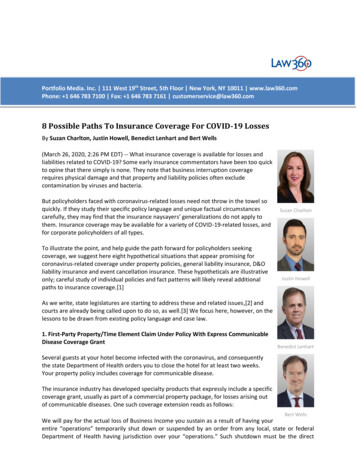
Transcription
Portfolio Media. Inc. 111 West 19th Street, 5th Floor New York, NY 10011 www.law360.comPhone: 1 646 783 7100 Fax: 1 646 783 7161 customerservice@law360.com8 Possible Paths To Insurance Coverage For COVID-19 LossesBy Suzan Charlton, Justin Howell, Benedict Lenhart and Bert Wells(March 26, 2020, 2:26 PM EDT) -- What insurance coverage is available for losses andliabilities related to COVID-19? Some early insurance commentators have been too quickto opine that there simply is none. They note that business interruption coveragerequires physical damage and that property and liability policies often excludecontamination by viruses and bacteria.But policyholders faced with coronavirus-related losses need not throw in the towel soquickly. If they study their specific policy language and unique factual circumstancescarefully, they may find that the insurance naysayers’ generalizations do not apply tothem. Insurance coverage may be available for a variety of COVID-19-related losses, andfor corporate policyholders of all types.To illustrate the point, and help guide the path forward for policyholders seekingcoverage, we suggest here eight hypothetical situations that appear promising forcoronavirus-related coverage under property policies, general liability insurance, D&Oliability insurance and event cancellation insurance. These hypotheticals are illustrativeonly; careful study of individual policies and fact patterns will likely reveal additionalpaths to insurance coverage.[1]Suzan CharltonJustin HowellAs we write, state legislatures are starting to address these and related issues,[2] andcourts are already being called upon to do so, as well.[3] We focus here, however, on thelessons to be drawn from existing policy language and case law.1. First-Party Property/Time Element Claim Under Policy With Express CommunicableDisease Coverage GrantBenedict LenhartSeveral guests at your hotel become infected with the coronavirus, and consequentlythe state Department of Health orders you to close the hotel for at least two weeks.Your property policy includes coverage for communicable disease.The insurance industry has developed specialty products that expressly include a specificcoverage grant, usually as part of a commercial property package, for losses arising outof communicable diseases. One such coverage extension reads as follows:Bert WellsWe will pay for the actual loss of Business Income you sustain as a result of having yourentire “operations” temporarily shut down or suspended by an order from any local, state or federalDepartment of Health having jurisdiction over your “operations.” Such shutdown must be the direct
result of an outbreak at the insured premises of a “communicable disease” such as, but not limited to,Meningitis, Measles, or Legionnaire's Disease, or to a “food contamination” caused directly by infectiousor bacterial organisms such as, but not limited to, infectious Hepatitis, E.Coli bacteria, or Salmonella. Anactual business shutdown must occur.[4]This provision defines “communicable disease” expansively, using the phrase “including but not limitedto.” Some policies define “communicable disease” to include losses arising from diseases that aretransmissible from human to human. Both formulations would likely include COVID-19, the diseasecaused by the coronavirus.In addition to the business interruption component, communicable disease coverage often includes thecosts of cleaning up a contaminated facility, as well as the costs of disposing of contaminated materials.It may even include PR costs related to reputational issues arising from the crisis.Importantly, if a policy contains a specific communicable disease coverage grant, this may negate theimpact of any contamination exclusion, particularly if the exclusion is phrased to except “loss or damageotherwise covered” by the policy.In addition, while some policies may have sublimits for communicable disease coverage, these sublimitsmay not apply where a communicable disease, such as COVID-19, leads to other losses covered by otherparts of the policy, such as business interruption or contingent business interruption coverage for lostrevenue or extra expense due to a plant shutdown or supply chain disruptions, as discussed further inScenarios 3-6 below. These coverages may not be subject to the communicable disease sublimits, andshould instead be subject to the policy’s overall limits (or other, typically larger sublimits).2. Event Cancellation Insurance ClaimYour company organizes a large annual music festival that draws thousands of attendees to the samestate park each year. Following an outbreak in another part of the state, and out of an abundance ofcaution, the governor issues an emergency order banning large public gatherings, forcing cancellation ofyour event.Organizers of large events like concerts, music festivals, sporting events, and trade shows oftenpurchase event cancellation insurance policies that may respond to losses arising from disruption orcancellation of events due to circumstances beyond the insured’s control. These policies varyconsiderably, and a particular policy may contain descriptions of the covered loss (or exclusions) that arespecific to the covered event. Careful attention to the policy wording is critical; but in the absence of aspecific on-point exclusion, an event cancellation policy should respond in the situation describedabove.Event cancellation policies commonly indemnify the insured for losses arising from the unavoidablecancellation, curtailment, postponement, removal to alternative premises, or abandonment of an event,and for any enforced reduced attendance. Notably, the loss generally must be caused by factors beyondthe control of the insured or the attendees: for example, an insurer would likely try to deny coverage forlosses from voluntary nonattendance due to generalized fear of infection (even here, however, somepolicies may language granting coverage in such a situation).If, however, a lawful order prohibits attendance by some (or, as in our hypothetical, all) attendees, thepolicy may well respond — absent an applicable exclusion.
A different scenario arises where absolute compulsion is lacking and the policyholder must make ajudgment call whether to cancel the event. If such a decision is made in order to avoid other coveredlosses, then the policyholder may have an opportunity to consult with the insurer to reach an agreedcancellation of the event, which might mitigate losses for both policyholder and insurer.In the absence of such consent, however, the unavoidability requirement, if it exists in the policy atissue, may present a challenge, but even in this case, the scope and severity of the coronavirus crisisshould support arguments that the cancellation was, in fact, unavoidable.Some, but not all, event cancellation policies contain a communicable disease exclusion. For example,some policies exclude coverage for losses:Directly or indirectly arising out of, contributed to by, or resulting from . any communicable diseasewhich leads to (a) the imposition of quarantine or restriction in movement of people or animals; (b) anytravel advisory or warning being issued by a national or international body or agency; and in respect ofa. or b. above any fear or threat thereof (whether actual or perceived).[5]Where such an exclusion is present, some policies define “communicable disease” as one that the WorldHealth Organization (or other relevant authority) has declared an epidemic or pandemic. On March 11,the Director General of the WHO declared the COVID-19 outbreak a pandemic.[6] If the governor’s orderin the above hypothetical were issued after such a declaration, an insurer may attempt to deny coverageunder an event cancellation policy with such a communicable disease exclusion, but even there apolicyholder may be able to point to other causes for the cancellation (e.g., logistical obstacles,government decisions, etc.) in order to avoid the exclusion.Before the pandemic declaration, however, an insurer would be on considerably weaker ground if itargued that prior WHO announcements, such as those identifying coronavirus as a global healthemergency,[7] could bring COVID-19 within its communicable disease exclusion.In short, while event cancellation policies may contain limitations, and both policy language and specificfactual circumstances need careful parsing, such policies should provide significant coverage forcoronavirus-related losses. Furthermore, even without an express cancellation coverage grant,protection for this scenario might yet apply, inter alia, if the policy contains the civil authority coveragediscussed in Scenario 6 below.3. First-Party Property/Time Element ClaimSeveral plant employees are diagnosed with COVID-19, and testing reveals coronavirus on surfaceswithin the plant’s premises and inside its HVAC systems. You shut down operations fordecontamination.The Telegraph recently reported that traces of the coronavirus have been found in the air ducts ofBritish hospitals.[8] That not-uncommon scenario forms the basis for this hypothetical. Although casesinvolving coronavirus in HVAC systems are as yet untested in the courts, analogous situations involvingasbestos, noxious odors, mold and carbon monoxide suggest that if the virus is present on HVACsystems, walls, floors, doors, equipment, and other inanimate objects, physical property damage maywell be found.[9] Some of the coronavirus-related orders issued by public authorities to date haveacknowledged as much.[10]Under an all risks commercial property policy, a common form of policy that covers all causes ofproperty damage that are not expressly excluded, coverage may exist for the costs of cleaning up the
property (assuming the policy lacks an express exclusion for virus contamination — see below).In addition, lost profits, extra shut-down related expenses and other components of covered loss duringdown time should be covered under such a policy with the business interruption coverage (one of theso-called time element coverages), so long as the interruption of operations and resulting loss resultedfrom the property damage.Even without physical damage to property per se, there is some support in the case law for coveragearising out of the inability to use the property.[11] Under this line of cases, if a policyholder suffers a lossdue to, for example, a harmful substance rendering the property unusable or uninhabitable, eventemporarily, that might be sufficient to satisfy the physical loss or damage requirement.[12]In other words, even if there has not been a tangible and permanently detrimental change to real orpersonal property, sufficient physical loss or damage may be present to trigger coverage for the loss ofuse of property.While many property policies contain exclusions for contamination by bacteria, viruses or communicabledisease, not all policies do. And some policies with such exclusions may not define their key terms, thusopening the door to a narrow interpretation of the exclusion by the courts.Other policies may define these terms or phrase the exclusions in a way that does not bar coverage forall coronavirus-related losses. For example, some policies have contamination exclusions withexceptions that preserve coverage for loss “caused directly by physical damage to the property covered by a peril not excluded in this policy.”[13] In some policies, this includes communicable diseasecoverage. Other policies, rather than purporting to exclude contamination as a cause of loss, may applylower sublimits to such losses.In short, the physical property damage requirement and/or the contamination exclusion found in manyfirst-party property policies are by no means insuperable obstacles to coverage, and many coronavirusrelated claims should qualify for coverage under the plain language of the policy. As noted above,additional support for coverage for this scenario may be found in prior court rulings that found coveragein analogous situations. Careful investigation of the facts — and scrupulous documentation of theevidence — will buttress the coverage claim.4. Ingress/Egress Claim Under First-Party Property/Time Element Insurance PolicyYour facility is inside the boundaries of a quarantined area, which has prevented ingress to or egressfrom your facility. This lack of access has required your business to shut down, even though nocoronavirus has been detected inside your plant or among your employees.While this scenario posits no physical damage to the policyholder’s facility, business interruptioncoverage might still be available to the extent that (1) the commercial property policy extends coverageto loss of ingress or egress from the insured property (another type of time element coverage); and (2)the basis for loss of ingress/egress is coronavirus-related property damage.Ingress/egress coverage is designed to pay for a loss of profits and other economic losses due to thesuspension of access to the insured's business. In some policies the prevention of ingress and egressmust be caused by a physical impediment, such as collapsed construction blocking the road, a mudslideor downed power lines. In other policies, however, the ingress/egress insuring clauses do not necessarilytie the facility’s inaccessibility to direct physical damage.[14] For example, one form provides as follows:
Loss of Ingress or Egress: This policy covers loss sustained during the period of time when, as a directresult of a peril not excluded, ingress to or egress from real and personal property not excludedhereunder, is thereby prevented.[15]In other words, depending on the policy language, a coronavirus-based quarantine order imposed on aparticular locality that prevents access to an insured location might trigger this coverage, even in theabsence of virus contamination or other physical damage to the insured property itself. And where theingress/egress coverage does require physical damage, that may well be satisfied by the presence ofcoronavirus near (but not at) the insured property at issue.5. Contingent Business Interruption Claim Under First-Party Property/Time Element Insurance PolicyYour supply chain was interrupted when a supplier shut down operations due to a coronaviruscontamination of its plant. Your facility was not contaminated, but you can no longer obtain all thesupplies or materials you need to continue operations and supply your own customers or clients in turn.Although this scenario lacks any coronavirus contamination or other damage at the policyholder’s ownfacility, coverage might be available under the contingent business interruption component of itscommercial property insurance, another type of time element coverage that property insurers offer andcorporate policyholders frequently opt to purchase.Contingent business interruption insurance expressly covers the policyholder’s lost profits and othereconomic losses that result from loss or damage to the property of a supplier (i.e., a third-party entityupstream in the supply chain) or a customer or client (i.e., a third-party downstream in the supplychain).Contingent business interruption coverage usually requires physical damage to customers’ or suppliers’property. Accordingly, if the policy is one in which (as discussed above) Coronavirus contaminationconstitutes physical damage, then the presence of coronavirus at the supplier’s plant resulting in ashutdown could trigger this coverage. Again, a careful investigation and documentation of the evidencemay reap insurance rewards.6. Civil Authority Claim Under First-Party Property/Time Element Insurance PolicyYour supply chain was interrupted when a supplier shut down plant operations due to a coronavirusrelated quarantine ordered by the government. Neither your supplier’s plant nor your facility sufferedcoronavirus contamination, but you can no longer obtain all supplies or materials you need to continueoperations and supply your own customers or clients in turn.Scenario 6 differs from Scenario 5 in that the cause of the supplier’s plant shutdown was a quarantineorder rather than coronavirus contamination at the supplier’s plant. The absence of covered propertydamage at the supplier’s plant, for the reasons discussed above, would ordinarily be a barrier tocontingent business interruption coverage.Nevertheless, coverage might be available under a civil authority coverage extension, if part of theapplicable policy. Similar to coverage for loss of ingress/egress, civil authority coverage reimburses lostprofits and other economic losses when a government entity has issued a legal order resulting in denialof access to the policyholder’s insured premises.While some civil authority provisions expressly require physical property damage,[16] others do not.[17]For example, some civil authority extensions simply “cover the loss sustained during the period of time
when, as a result of a peril not excluded, access to real or personal property is prohibited by order ofcivil or military authority.”[18]Thus, as long as the peril itself is not expressly excluded from this all-risk policy, losses arising out of acoronavirus quarantine order that shutters or slows down a supplier’s business may be recoverable. Andwhere the civil authority coverage does require physical damage, this may be established by themethods discussed above (e.g., presence of coronavirus within the required area).7. Claim Under Directors and Officers Liability Insurance PolicyIn Scenario 6 above, the interrupted supply chain leads to a halt of production at your facility and, as aconsequence, the share price of your publicly traded company plummets. An ensuing putativeshareholder class action against your company and certain directors and officers alleges violation of thesecurities laws for failure to disclose material information about the company’s exposure to adversefinancial impacts from the pandemic.On March 4, the U.S. Securities and Exchange Commission issued a press release reminding companiesproperly to inform investors of coronavirus-related risks of which they are aware.[19] A scenario like theone described above contemplates allegations that such guidance was not followed, and implicatescoverage under a directors and officers liability policy.Such policies typically cover the corporate entity for securities claims such as the one hypothesizedunder their so-called Side C coverage, as well as claims against individual directors and officers, wherewrongful acts are alleged. That term is typically defined broadly, as “any error, misstatement, misleadingstatement, act, omission, neglect, or breach of duty actually or allegedly committed or attempted.”[20]While this D&O coverage grant is broad, insurers may assert the bodily injury/property damageexclusion or the pollution exclusion commonly found in D&O policy forms.The bodily injury/property damage exclusion in most D&O liability policies applies to claims “for bodilyinjury . sickness, disease or death of any person, or damage to or destruction of any tangibleproperty.”[21]A policyholder would have good arguments that a shareholder suit alleging failure to disclosecoronavirus-related business risk does not constitute a claim “for” bodily injury or property damage: It isthe very type of securities claim for which D&O policies are marketed and sold, not a tort claim allegingphysical harm caused by the policyholder. Otherwise stated, this is a dove-tailing exclusion, whichallocates claims that are traditionally the subject of general liability insurance to that line of coverage.Some D&O insurers may resist coverage, citing broader causation terms, such as “based upon” or“arising out of,” which have crept into the bodily injury/property damage exclusion. But stretching suchboiler-plate causation language to SEC disclosure obligations allegedly relating in any way to injury ordamage not only distorts the ordinary meaning of these terms in their context, but also would violatereasonable expectations of coverage for a wide range of securities claims not limited to those relating tothe coronavirus.As applied to a securities class action alleging a stock price drop attributable to the general decline ofeconomic activity from a pandemic, many courts would hold that this exclusion, even in its broadestwording, is at best ambiguous; and under well-established doctrines of insurance contract constructionthat ambiguity is resolved in favor of coverage.
Finally, some D&O policies contain a clear-cut savings clause for securities claims that arise from mattersotherwise within the scope of the injury/damage exclusion, cutting through any possible doubt aboutthe availability of coverage under this scenario.[22] Accordingly, policyholders should pay carefulattention to the specific wording of personal injury/property damage exclusions, as well as to thebroader principles of construction that would account for its intended function in their D&O liabilitypolicies.Turning to D&O policies’ pollution exclusions, a wording with broad causation terms reads as follows:The insurer shall not be liable for Loss on account of any Claim made against any Insured . based upon,arising out of, or attributable to (a) the actual, alleged, or threatened discharge, release, escape,seepage, migration or disposal of Pollutants into or on real or personal property, water or theatmosphere; or (b) any direction or request that the Insureds test for, monitor, clean up, remove,contain, treat, detoxify or neutralize Pollutants, or any voluntary decision to do so.[23]Other policies may have the narrower “for” causation language, thus further limiting the scope of thisexclusion. But even where the broad causation language is present, the policyholder can point to thecausation arguments and general interpretive principles discussed above. In addition, the specificdefinition of “pollutants” or “pollution” in a D&O policy may be a critical factor in the potentialapplication of the pollution exclusion.As with the term “contamination” in property policies (see Scenario 1 above), a D&O policyholder mightwell find that the term “pollution” is not defined in its policy in a manner that clearly and conspicuouslyencompasses coronavirus, in which case the exclusion should be inapplicable.8. Claim Under Commercial General Liability Insurance PolicyA cruise line learns that some passengers on its flagship vessel are infected with coronavirus. Authoritiesat the vessel’s intended port allow it to dock, but order that all passengers remain onboard for a 14-dayquarantine period. During that time, the virus spreads to other passengers. Infected passengers latersue the cruise line for their medical expenses and pain and suffering; uninfected passengers sue for falseimprisonment.In response to third-party claims alleging direct responsibility for coronavirus-related harms, companieslike the cruise line in this hypothetical can be expected to look to their commercial general liabilitypolicies as a first line of defense. CGL policies characteristically cover “those sums that the insuredbecomes legally obligated to pay as damages because of ‘bodily injury’ or ‘property damage’ to whichthis insurance applies.”[24]“Bodily injury” is typically defined (somewhat circularly) to include “bodily injury, sickness, or diseasesustained by a person, including death resulting from any of these at any time.”[25] Thus, an infectedpassenger’s claim that the cruise line negligently allowed coronavirus to spread onboard would fallwithin the coverage grant.The uninfected passengers’ claims for false imprisonment present a slightly different question — if thepassengers have not been infected or otherwise physically harmed, they probably don’t meet the“bodily injury” requirement. However, CGL policies usually provide so-called Coverage B protection for“sums the insured becomes legally obligated to pay as damages because of ‘personal and advertisinginjury’ to which this insurance applies.”[26]
“Personal and advertising injury” is further defined to include injury “arising out of . [f]alse arrest,detention, or imprisonment” under the standard CGL form.[27] Accordingly, the hypothetical falsearrest claims may well fall within this CGL coverage grant.A potential impediment to CGL coverage could be an exclusion for communicable disease, discussedabove, to the extent it is present in a policy (and it is not always present). While the insurers will arguethat exclusion would bar coverage for a bodily injury claim, its effect is less clear with respect to a falseimprisonment claim by an uninfected passenger, which is predicated not on the transmission of adisease, but on measures taken to prevent its transmission.Again, careful attention to the policy language, as well as careful analysis and documentation of thespecific facts, may result in CGL coverage protection for serious tort claims such as those in thishypothetical.ConclusionPolicyholders with COVID-19 or coronavirus-related losses or liabilities should carefully analyze theirproperty, event cancellation, CGL, D&O and other insurance policies. Substantial coverage will almostcertainly exist under some or all of these policies for some coronavirus or COVID-19 claims.Whether or not coverage applies for any specific coronavirus losses will depend largely on the precisewording of the policies and the specific pattern of the facts, along with the applicable case law. Properunderstanding of potentially applicable policy language — both the words used and the words omitted— is critical. Understanding the legal landscape governing the interpretation and application of thosewords will likewise help identify avenues to coverage, obstacles to coverage and potential coverage gapsto fill at renewal time.Suzan Charlton is special counsel, Justin Howell is an associate, and Benedict Lenhart and Bert Wells arepartners at Covington & Burling LLP.The opinions expressed are those of the author(s) and do not necessarily reflect the views of the firm, itsclients, or Portfolio Media Inc., or any of its or their respective affiliates. This article is for generalinformation purposes and is not intended to be and should not be taken as legal advice.[1] In addition to the four types of policies examined here — D&O, GL, Event Cancelation and Property— coverage for coronavirus-related losses may arise under a wide variety of other policies, includingrepresentations and warranties, employment practices liability, trade credit, and errors and omissionspolicies.[2] For example, the New Jersey state legislature is considering a bill that would mandate coverage forclaims “due to global virus transmission or pandemic” for small businesses, while allowing insurers toseek reimbursement from a state fund. New Jersey Bill A-3844 (draft), reportedat https://www.insidernj.com/assembly-agenda-monday/. While insurance industry opposition to thismeasure seems likely, more robust legislative initiatives may ultimately become law in New Jersey orelsewhere and may prove helpful to some policyholders.[3] See, e.g., Cajun Conti, et al vs. Certain Underwriters at Lloyd’s, London, No. 2020-02558 (LouisianaDistrict Court, Orleans Parish), filed on March 17, 2020.
[4] Markel Insurance Company, Form No. MCP 011 (01/07).[5] Hiscox Organisers Cancellation and Abandonment Wording 7613 03/09, availableat ent.pdf (accessed 3/15/20).[6] Donald G. McNeil, Jr., Coronavirus Has Become a Pandemic, W.H.O. Says, N.Y. Times (Mar. 11, 2020),available at rus-pandemic-who.html (accessed3/13/20).[7] Sui-Lee Wee, et al., W.H.O. Declares Global Emergency as Wuhan Coronavirus Spreads, N.Y. Times(Jan. 30, 2020), available at rus-world-healthorganization.html (accessed 3/13/20).[8] Henry Bodkin, Air Conditioning Systems Could Spread Coronavirus, Research Shows, The Telegraph(Mar. 6, 2020), available at h-shows/ (accessed 3/18/20). However, the CDC stated in earlyFebruary, 2020 (approximately one month before the report in The Telegraph) that it had “no currentevidence to suggest that the virus spreads through the air-handling system.” U.S. Dep’t of Health andHuman Serv’s, Centers for Disease Control and Prevention, Letter to U.S. Passenger/Crew Member ofDiamond Princess (February 8, 2020), available at -for-diamond-princess.pdf (accessed 3/13/20). Accordingly it appears that further research andstudy may be required to ascertain whether HVAC contamination may be a vector for Coronavirustransmission.[9] See, e.g., Sentinel Management Co. v. New Hampshire Ins. Co., 563 N.W.2d 296 (Minn. App. 1997)(released asbestos was direct physical loss, even though no tangible injury to the physical structure ofbuilding resulted from the release, no regulation required the insured to abate the asbestos, and thebuilding remained occupied); Farmers Ins. Co. of Oregon v. Trutanich, 858 P.2d 1332 (Or. App. 1993)(strong, persistent odor from an illegal methamphetamine laboratory in rented house qualified as“accidental direct physical loss”); Sullivan v. Standard Fire Ins. Co., 956 A.2d 643 (Del. 2008)(unpublished) (mold contamination was “physical loss” because mold spores “undoubtedly have a‘material existence,’ even though they are not tangible or perceptible by the naked eye”); Matzner v.Seaco Ins. Co., 1998 WL 566658 (Mass. Superior Ct. 1998) (carbon monoxide infiltration due to blockedchimney constituted a “direct physical loss”).While these decisions support coverage, it is important to note that not all courts agree, and none hasyet addressed this particular factual situation.
(March 26, 2020, 2:26 PM EDT) -- What insurance coverage is available for losses and liabilities related to COVID-19? Some early insurance commentators have been too quick to opine that there simply is none. They note that business interruption coverage requires physical damage and that property and liability policies often exclude
